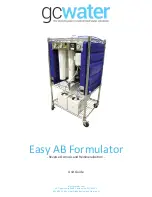
57
Poor Product Water Quality
With any product water quality issue, you must ensure accurate calibration if you are using a
salinity meter. For general quality evaluation, your taste is always good enough.
Membranes are not an exact science and two identical systems can have different product
quality. World health standards deem water of up to 1000 PPM of total dissolved solids ac-
ceptable for drinking. We consider any thing below 750 PPM acceptable but not ideal, and
anything below 500 PPM excellent. Factors that could affect water quality are addressed be-
low.
LOW SYSTEM FLOW OR PRESSURE will equate to lower product quality (higher PPM). Bi-
mini systems, which have a higher feed to output pressure ratio (See nominal pres-
sures under Flow Test, page 60), as well as a higher feed flow/membrane area ratio,
will produce water in the 150
-
300 PPM range.
DAMAGE TO THE MEMBRANE by chlorine contamination. Flushing the system with chlo-
rinated water will irreparably damage the membrane. Charcoal filters are used to ab-
sorb any chlorine which might be present in flush water. They must be of proper
specification to be suitable. See page 64. There is no test for chlorine damage except
the process of elimination of other causes.
DIRTY OR SCALED membranes. A dirty (foreign material), scaled (mineral deposits), or
contaminated (bacterial growth) membrane can result in poor water quality and ab-
normal operating pressures. If operating pressures are above normal, then cleaning is
indicated. If the system pressures are within operating normal range, cleaning may
have little result. Avoid cleaning as a diagnostic tool. Low water quality after storage
with propylene glycol can usually be remedied by extended flushing or an SC
-
2 clean-
ing. (See pages 52
-
53.)
MECHANICAL LEAKAGE within the membrane pressure vessel. This is an unlikely but pos-
sible cause of poor water quality. A pinched or damaged O
-
ring within the pressure
vessel, a scratch on the product tube on the membrane, a scratch within one of the
end caps, or a seal fouled by contamination could allow sea water into the product
water.
If system total flow (product plus brine) is 2.4 GPM (9 liters) or above, the membrane is
clean, the product flows are consistent with the system flow and the water quality is still not
acceptable, then replacement of the membrane is indicated.
Summary of Contents for Bimini 300
Page 1: ......
Page 2: ...2 ...
Page 4: ...4 ...
Page 6: ...6 ...
Page 8: ...8 ...
Page 10: ...10 Installation Notes ...
Page 19: ...19 John Guest Super Speedfit Fittings ...
Page 67: ...67 Wiring Schematic ...
Page 77: ...77 Parts 1 SO HPP PR10 ...
Page 78: ...78 Parts PL MTS 3 8X1 2B HP CYL SST HP CYL CCA SO HPP ECCB HP CYL EC HP CYL R HP CYL PT Parts ...
















































